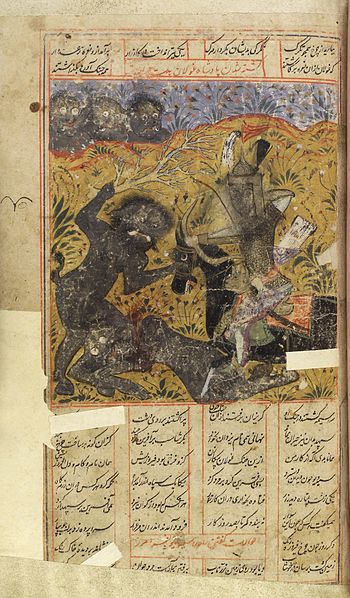Jinn, also romanized as djinn or anglicized as genies, are invisible creatures in early pre-Islamic Arabia and later in Islamic culture and beliefs.
Like humans, they are accountable for their deeds and can be either believers (Muslims) or disbelievers (kafir), depending on whether they accept God's guidance. Since jinn are neither innately evil nor innately good, Islam acknowledged spirits from other religions and was able to adapt them during its expansion. Jinn are not a strictly Islamic concept; they may represent several pagan beliefs integrated into Islam. To assert a strict monotheism and the Islamic concept of tawhid, Islam denies all affinities between the jinn and God, thus placing the jinn parallel to humans, also subject to God's judgment and afterlife. The Quran condemns the pre-Islamic Arabian practice of worshipping or seeking protection from them.
Jinn
The winged genie in the bucket and cone motif, depicting a demi-divine entity, probably a forerunner of the pre-Islamic tutelary deities, who became the jinn in Islam. Relief from the north wall of the Palace of king Sargon II at Dur Sharrukin, 713–716 BCE.
A Sinai desert cobra. Snakes are the animals most frequently associated with jinn. Black snakes are commonly believed to be evil jinn, whereas white snakes are held to be benign (Muslim) jinn.
The 72nd chapter of the Qur'an entitled Al-Jinn (The Jinn), as well as the heading and introductory bismillah of the next chapter entitled al-Muzzammil (The Enshrouded One)
Religion in pre-Islamic Arabia
Religion in pre-Islamic Arabia included indigenous Arabian polytheism, ancient Semitic religions, Christianity, Judaism, Mandaeism, and Zoroastrianism.
Alabaster votive figurines from Yemen, now in the National Museum of Oriental Art, Rome
Gilded statue of the Canaanite creator god El, BC. 1400–1200 El-Megiddo. El is considered the origin of the words Ilah and continues to appear in compound names such as Gabriel, Michael, Azrael, Ishmael, etc.
Nabataean baetyl depicting a goddess, possibly al-Uzza.
Bas-relief: Nemesis, al-Lat and the dedicator. Palmyrene, 2nd–3rd century AD.








